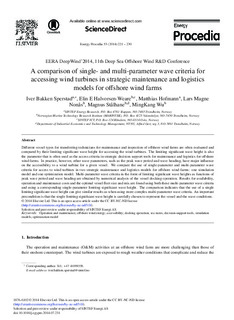| dc.contributor.author | Sperstad, Iver Bakken | |
| dc.contributor.author | Halvorsen-Weare, Elin Espeland | |
| dc.contributor.author | Hofmann, Matthias | |
| dc.contributor.author | Nonås, Lars Magne | |
| dc.contributor.author | Stålhane, Magnus | |
| dc.contributor.author | Wu, MingKang | |
| dc.date.accessioned | 2017-10-06T06:20:44Z | |
| dc.date.available | 2017-10-06T06:20:44Z | |
| dc.date.created | 2014-09-18T10:10:31Z | |
| dc.date.issued | 2014 | |
| dc.identifier.citation | Energy Procedia. 2014, 53 221-230. | nb_NO |
| dc.identifier.issn | 1876-6102 | |
| dc.identifier.uri | http://hdl.handle.net/11250/2458821 | |
| dc.description.abstract | Different vessel types for transferring technicians for maintenance and inspection of offshore wind farms are often evaluated and compared by their limiting significant wave height for accessing the wind turbines. The limiting significant wave height is also the parameter that is often used as the access criteria in strategic decision support tools for maintenance and logistics for offshore wind farms. In practice, however, other wave parameters, such as the peak wave period and wave heading, have major influence on the accessibility to a wind turbine for a given vessel. We compare the use of single-parameter and multi-parameter wave criteria for access to wind turbines in two strategic maintenance and logistics models for offshore wind farms: one simulation model and one optimization model. Multi-parameter wave criteria in the form of limiting significant wave heights as functions of peak wave period and wave heading are obtained by numerical analysis of the vessel docking operation. Results for availability, operation and maintenance costs and the optimal vessel fleet size and mix are found using both these multi-parameter wave criteria and using a corresponding single-parameter limiting significant wave height. The comparison indicates that the use of a single limiting significant wave height can give similar results as when using more complex multi-parameter wave criteria. An important precondition is that the single limiting significant wave height is carefully chosen to represent the vessel and the wave conditions. | |
| dc.language.iso | eng | nb_NO |
| dc.rights | Attribution-NonCommercial-NoDerivatives 4.0 Internasjonal | * |
| dc.rights.uri | http://creativecommons.org/licenses/by-nc-nd/4.0/deed.no | * |
| dc.title | A Comparison of Single- and Multi-parameter Wave Criteria for Accessing Wind Turbines in Strategic Maintenance and Logistics Models for Offshore Wind Farms | nb_NO |
| dc.type | Journal article | nb_NO |
| dc.type | Peer reviewed | nb_NO |
| dc.description.version | publishedVersion | |
| dc.source.pagenumber | 221-230 | nb_NO |
| dc.source.volume | 53 | nb_NO |
| dc.source.journal | Energy Procedia | nb_NO |
| dc.identifier.doi | 10.1016/j.egypro.2014.07.231 | |
| dc.identifier.cristin | 1155638 | |
| dc.relation.project | Norges forskningsråd: 205298 | nb_NO |
| dc.relation.project | Norges forskningsråd: 217443 | nb_NO |
| dc.relation.project | Norges forskningsråd: 193823 | nb_NO |
| cristin.unitcode | 7548,50,0,0 | |
| cristin.unitcode | 7401,90,11,0 | |
| cristin.unitcode | 7566,7,0,0 | |
| cristin.unitcode | 7566,9,0,0 | |
| cristin.unitname | Energisystemer | |
| cristin.unitname | Anvendt matematikk | |
| cristin.unitname | Maritim | |
| cristin.unitname | Hydrodynamikk | |
| cristin.ispublished | true | |
| cristin.fulltext | original | |
| cristin.qualitycode | 1 | |

